This article was published in Scientific American’s former blog network and reflects the views of the author, not necessarily those of Scientific American
To my surprise, I can’t find any clear evidence that I’ve ever blogged about secretary birds. They’re great and I’ve spent a lot of time gawping at them (both lives ones – in captivity – and skeletal specimens). Here are brief thoughts.
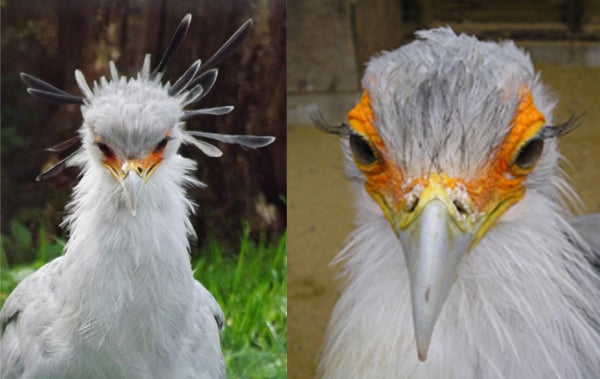
Head plumes and fantastic eyelashes. Different captive individuals. Credit: Darren Naish
Secretary birds are represented today by the sole species Sagittarius serpentarius of sub-Saharan African grasslands, famous for its long black head plumes and snake-stomping predatory behaviour. It has especially short, robust toes, as expected for a terrestrial walker that uses its feet as stomping weapons, and is able to stomp with a force equivalent to about five times its body weight (Portugal et al. 2016). The legs are feathered all the way down to the ankle joint (so, the shins are feathered, not just ‘the thighs’ as typically stated in bird books). The naked facial skin is orange or reddish in adults, the eyelashes are long and prominent, and the bird presumably uses binocular vision to target prey items. Sagittarius is large, reaching 1.3 m in height, 1.5 m in length and c 2 m in wingspan.
On supporting science journalism
If you're enjoying this article, consider supporting our award-winning journalism by subscribing. By purchasing a subscription you are helping to ensure the future of impactful stories about the discoveries and ideas shaping our world today.
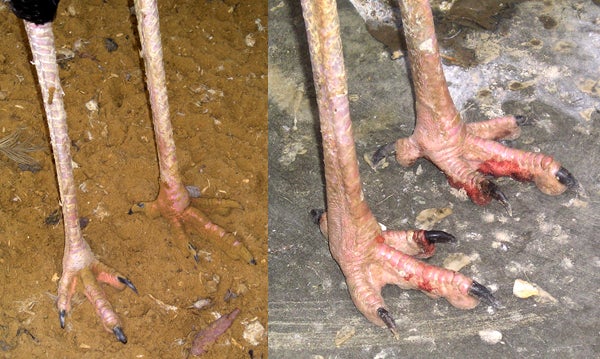
It all feels a bit weird now, but I have lots of photos of Secretary bird feet on one of my hard-drives. These feet belong to different individuals. Note the short, stocky nature of most of the toes. Credit: Darren Naish
Every single book on raptors states that the head plumes explain its common name, secretaries – or, rather, lawyer’s clerks – of the past apparently being in the habit of keeping feather quills tucked behind their ears or thereabouts (the section of text you’ve just read being semi-paraphrased from more than one popular book on raptors). I rather like and prefer the little-known alternative explanation that ‘secretary’ is a corrupted misunderstanding of a term possibly used in Arabic – saqr et-tair – which was adopted by French traders as secrétaire and then translated into English (Fry 1977).
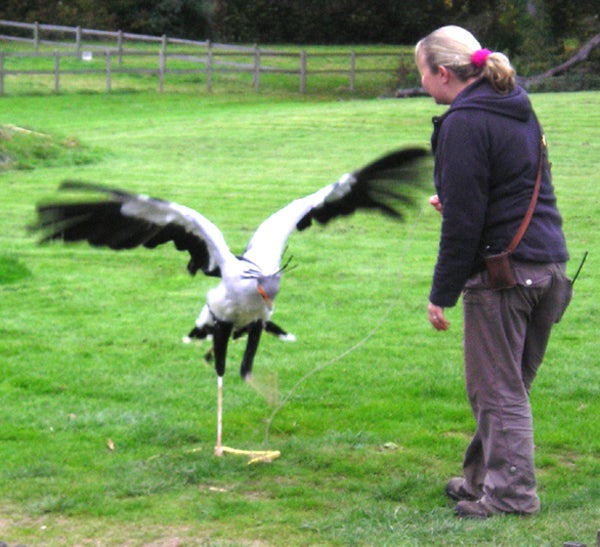
It isn't at all difficult to get trained captive secretary birds to attack toy snakes as and when required. This is Tiger, a captive bird at the International Bird of Prey Centre, Gloucestershire (UK), displaying prowess. Credit: Darren Naish
Despite being best known as a terrestrial walker that forages for ground-dwelling prey, the secretary bird is agile in the air, capable of flying at great height (as in, c 3600 m: Brown 1976), and it indulges in undulating display flights and loud calling, as do accipitrid raptors. It is also accipitrid-like in squirting (rather than just dropping) its droppings -- yes, this is a neat and variable aspect of behaviour you can map onto phylogeny -- in building its own large nest in a tree, and in laying bluish-green eggs where the eggshell is greenish inside. Prey is carried to the nest in the bill or crop (those feet are not much good when it comes to carrying things).
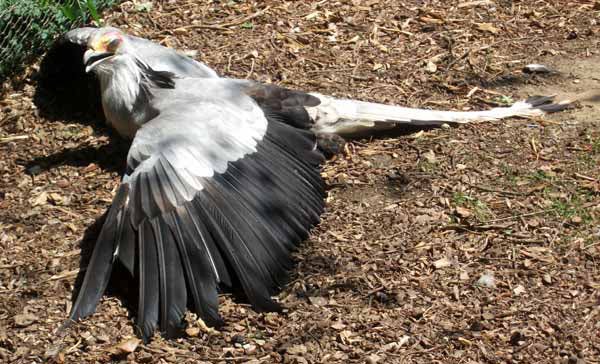
An image you might have seen on Tet Zoo a few times before: a sunbathing (captive) Secretary bird. Credit: Darren Naish
Indeed, for all its weirdness, there are aspect of secretary bird anatomy, biology and behaviour that are not weird at all and thus it is that some raptor specialists have long been unashamed of saying that it is essentially a big, long-legged eagle, of sorts. Remember that even its terrestrial, ground-stalking behaviour is not that odd: many accipitrids hunt this way, at least on occasion, among them Bateleurs Terathopius ecaudatus and chanting goshawks (Melierax). Read on to see what phylogenetic studies have to say about all of this.
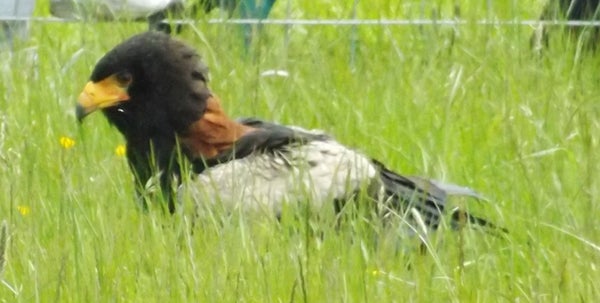
Terrestrial foraging on foot is not that unusual among accipitrid raptors. You might think of Terathopius as a supreme aerialist, and it is. But it will also prowl around on the ground like a big predatory chicken. Credit: Darren Naish
The reliance of the secretary bird on snakes has been exaggerated and other prey animals include large arthropods, small mammals, tortoises, lizards and small birds and their eggs. A few reports describe the killing of juvenile gazelles and cheetahs.
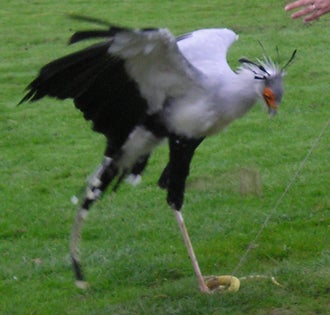
Another image of Tiger in action. Credit: Darren Naish
Several fossil secretary birds are known. The oldest is Pelargopappus from the Lower and Upper Oligocene Quercy fissure deposits of France. It appears to have been similar to Sagittarius overall though somewhat smaller. Secretary birds have long been considered ‘distinct enough’ relative to other raptors – Accipitriformes – that they’ve not only been given their own family (Sagittariidae) but sometimes their own higher group too (Sagittaroidea… shouldn’t this actually be Sagittarioidea?). A superficial similarity to the South American seriemas has led to occasional suggestions that secretary birds might not be raptors at all but actually members of whatever group it is that seriemas belong to (an issue I’ll avoid for now). This is absolutely contradicted by anatomical and molecular data (as well as by the behaviour and other traits discussed above), recent molecular work consistently finding secretary birds to be the sister-group to the osprey + accipitrid clade (Lerner & Mindell 2005, Hackett et al. 2008, Prum et al. 2015) [see the comments below for discussion on why Sagittariidae should probably be maintained as a distinct ‘family’].
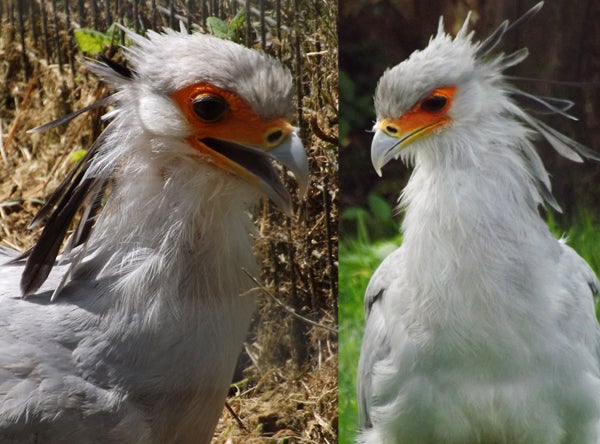
The hawk on stilts. A close relative of the hawks and eagles you know so well. Credit: Darren Naish
For previous Tet Zoo articles on birds of prey, see…
Refs - -
Brown, L. H. 1997. Birds of Prey. Chancellor Press, London.
Fry, C. H. 1977. Etymology of ‘Secretary-bird’. Ibis 119, 550.
Lerner, H. R. L. & Mindell, D. P. 2005. Phylogeny of eagles, Old World vultures, and other Accipitridae based on nuclear and mitochondrial DNA. Molecular Phylogenetics and Evolution 37, 327-346.
Portugal, S. J., Murn, C. P., Sparkes, E. L. & Daley, M. A. 2016. The fast and forceful kicking strike of the secretary bird. Current Biology 26, R58-R59.
Prum, R. O., Berv, J. S., Dornburg, A., Field, D. J., Townsend, J. P., Moriarty Lemmon, E. & Lemmon, A. R. 2015. A comprehensive phylogeny of birds (Aves) using targeted next-generation DNA sequencing. Nature doi:10.1038/nature15697